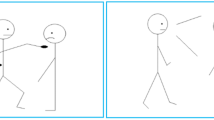Abstract
We report on an observational study on sex differences in serious and playful aggression in early childhood. The sample included 14 girls and 14 boys, aged 2 to 4. The study was carried out in Porto Alegre, Brazil. Half of the subjects attended a nursery school for children from a favela (slum district); the others attended a nursery school that was run by a local university and represented the life conditions of the middle class of the Brazilian society. Each of the children was observed at school for 3 hours (divided into 12–15 minutes episodes) through a focal sampling technique. Significant sex differences are found for the frequency of playful aggression for both the actor's and the “victim's” part of the aggressive act, but for the actor's role the effect holds only for the middle class setting. There are also tremendous differences between the frequencies of serious aggression in girls and some of the boys, although the effect is not statistically significant. When several types of aggression are compared, it becomes evident that sex differences are restricted to bullying (dominant aggression). The rates of instrumental and reactive aggression are similar in both sexes. Girls and boys from the favela setting do not differ in the relative importance of the different types of serious aggression, but in middle class children the proportion of acts of bullying is much higher in boys than in girls.
Similar content being viewed by others
References
Altmann, J. (1974). Observational study of behavior: Sampling methods.Behavior, 49 227–267.
Boulton, M., & Smith, P. K. (1989). Issues in the study of children's rough-and-tumble play. In M. N. Bloch & A. D. Pellegrini (Eds.),The ecological context of children's play. Norwood, NJ: Ablex.
Brennan, R. L., & Prediger, D. J. (1981). Coefficient kappa: Some uses, misuses, and alternatives.Educational and Psychological Measurement, 41 687–699.
Bretherton, I. (1989). Pretense: The form and function of make-believe play.Developmental Review, 9 383–401.
Cohen, J. (1960). A coefficient of agreement for nominal scales.Educational and Psychological Measurement, 20 37–46.
Coie, J. D., Dodge, K. A., Terry, R., & Wright, R. (1991). The role of aggression in peer relations: An analysis of aggression episodes in boys' play groups.Child Development, 62 812–826.
Dodge, K. A. (1991). The structure and function of reactive and proactive aggression. In K. H. Rubin & D. J. Pepler (Eds.),The development and treatment of childhood aggression. Hillsdale, NJ: Erlbaum.
Dodge, K. A., Coie, J. D., Pettit, G. S., & Price, J. M. (1990). Peer status and aggression in boys' groups: Developmental and contextual analyses.Child Development, 61 1289–1309.
DiPietro, J. A. (1981). Rough and tumble play: A function of gender.Developmental Psychology, 17 50–58.
Fry, D. P. (1987). Differences between play fighting and serious fighting among Zapotec children.Ethology and Sociobiology, 8 285–306.
Fry, D. P. (1988). Intercommunity differences in aggression among Zapotec children.Child Development, 59 1008–1019.
Fry, D. P. (1990). Play aggression among Zapotec children: Implications for the practice hypothesis.Aggressive Behavior, 16 321–340.
Hoppe-Graff, S., & Frey, C. (1993).Ernsthafte und gespielte Aggressionen im Kindergarten [Serious and playful aggression in the nursery school]. Unpublished manuscript (submitted for publication), University of Heidelberg.
Humphreys, A. P., & Smith, P. K. (1984). Rough-and-tumble play in preschool and playgrounds. In P. K. Smith (Ed.),Play in animals and humans. Oxford: Blackwell.
Hyde, J. S. (1984). How large are gender differences in aggression? A developmental meta-analysis.Developmental Psychology, 20 722–736.
Maccoby, E. E., & Jacklin, C. N. (1974).The psychology of sex differences. Stanford, CA: Stanford University Press.
Maccoby, E. E., & Jacklin, C. N. (1980). Sex differences in aggression: A rejoinder.Child Development, 51 964–980.
McCabe, A., & Lipscomb, T. J. (1988). Sex differences in children's verbal aggression.Merrill-Palmer Quarterly, 34 389–401.
Pellegrini, A. D. (1988). Elementary-school children's rough-and-tumble play and social competence.Developmental Psychology, 24 802–806.
Piaget, J. (1962).Play, dreams, and imitation in childhood. New York: Norton (Original publication 1945).
Rubin, K. H., Fein, G. G., & Vandenberg, B. (1983). Play. In E. M. Hetherington (Ed.),Handbook of child psychology. Vol. IV. Socialization, personality, and social development. New York: Wiley.
Smith, P. K. (1982). Does play matter? Functional and evolutionary aspects of animal and human play.The Behavioral and Brain Sciences, 5 139–184.
Smith, P. K., & Boulton, M. (1990). Rough-and-tumble play, aggression and dominance: Perception and behaviour in children's encounters.Human Development, 33 271–282.
Tieger, T. (1980). On the biological basis of sex differences in aggression.Child Development, 51 943–963.
Vygotsky, L. S. (1967). Play and its role in the mental development of the child.Soviet Psychology, 12 62–76.
Waelder, R. (1933). The psychoanalytic theory of play.Psychoanalytic Quarterly, 2 208–224.
Author information
Authors and Affiliations
Additional information
Revised and elaborated version of the contribution to the Paper Session onFemale Aggression at the90th Annual Meeting of the American Anthropological Association in Chicago, 1991. We thank Claúdio Simon Hutz and Tânia Sperb who helped us to carry out the observations and Simone Schenk and Iris Seltenreich for help in data analysis. We are also grateful to the children and the staff of two nursery schools in Porto Alegre, Brazil, who participated in the study.
Rights and permissions
About this article
Cite this article
Frey, C., Hoppe-Graff, S. Serious and playful aggression in Brazilian girls and boys. Sex Roles 30, 249–268 (1994). https://doi.org/10.1007/BF01420993
Issue Date:
DOI: https://doi.org/10.1007/BF01420993




